#Substitute Modular
Explore tagged Tumblr posts
Text
Unleash Your Inner Sound Alchemist: Exploring Substitute Modular, the Free Virtual Synth by FlandersH
For music producers and sound designers on a budget, the search for powerful yet accessible virtual instruments can feel like a never-ending quest. But fear not, because FlandersH, a company dedicated to pushing the boundaries of music technology, has unveiled a game-changer: Substitute Modular, a free virtual analog synthesizer brimming with creative potential. Substitute Modular isn’t your…

View On WordPress
#analog synth#FlandersH#free virtual synth#modular synth#music production#sound design#sound effects#Substitute Modular#virtual instrument
1 note
·
View note
Text

Hiiii friendssss! What the FUCK is up. What the fuck is up. What the Fuck is up. On todays cute little cookin excursion we are going to be deep frying things and using a wok. If you dont feel comfortable deep frying, and dont have a wok, im sure theres other ways to do it silly :DDD
I believe in you.
From LotR online we're gonna be making Fried Beetroot Sticks!!
(As always you can find the cooking instructions and full ingredient list under the break-)
MY NAMES CROSS NOW LETS COOK LIKE ANIMALS
SO, “what goes into Fried Beetroot Sticks?” YOU MIGHT ASKSlices of sweet little beated root dipped into a batter with, watch out, special flavors too.
2 Beetroots
Corn flour
Salt
Red Chilli Powder
Garlic Paste
Baking Soda
Water
Peanut oil
And we'll also be making some horseradish sour cream dip to go along with it;
Sour cream
Prepared horseradish
1 Green onion
Few splashes of lemon juice
Salt to taste
Ground pepper to taste
"Cooked, tender beetroot sticks are dredged in a light batter and fried to give a crispy exterior and a soft, sweet interior. Served with a bracing horseradish sour cream, this snack is both filling and delicious."- LotRO Tooltip
AND, “what does Fried Beetroot Sticks taste like?” YOU MIGHT ASKThis is like homemade fair-food and it sounds like a contradiction but its not
But maybe its just because its fried food? American brained, sorry.
Retains the inherit sweetness to beetroot
And similar to pickled beetroot the sweetness contrasts the spicey of the batter
(which i encourage you to amp up if youd like more spice)
The horseradish sourcream dip is to die for
Measure with your heart for that one, and save some green onion to top it with when you serve
This would pair very well with a lime italian soda or with shaved ice cones
Im always very anxious about deep-frying things, or working with oils at high temperatures, but i didnt run into any complications with this dish. Just make sure to keep best practices and safety precaution in mind, especially with a wok as it can tilt!
. If you dont have corn flour, you can substitute all-purpose flour . If you dont have peanut oil, look up oils with the same smokepoint to decide what else to use
-----------------------------------------------------------------------------------------------------------
The recipe stuck out to me, as i was assembling a list of foodstuffs from tolkiens work, for being such a "regular" named food. Also its worth 19 silver 69 copper in the LotR MMO and im immature.
I think the dip has the most room for improvement and tinkering. I've never made horseradish sourcream before, so more practiced tastebuds could perfect a simple thing like this. In the future id also like to try adding red pepper flakes along with the the powder and garlic paste, to give more visual variety and spice. I think cumin in the batter would be a nice midtone flavor too.
I give this recipe a solid 8/10 (with 1 being food that makes one physically sick and 10 being food that gives one a lust for life again.) for its relative simplicity and modularity with things you could add.
🐁 ORIGINAL RESIPPY TEXT BELOW 🐁
Beetroot Sticks Ingredients:
2 Beetroots
130 grams corn flour
1 tbsp salt
1 tsp Red Chilli Powder
1 tsp Garlic Paste
1/4 tsp Baking Soda
178 grams Water
432 grams peanut oil
Horseradish Sour Cream Ingredients:
225 grams Sour cream
200 grams Prepared horseradish
1 whole green onion (green and white parts VERY finely chopped)
1 tspn lemon juice
Salt to taste
ground pepper to taste
Beetroot Method:
Peel all beetroots and cut them length-wise into rectangles.
Combine flour, salt, chilli powder, garlic paste, baking soda, and water in a bowl.
Mix well into a smooth batter.
Heat peanut oil to medium in a wok and dip beet roots into batter. Deep fry until golden brown in color.
Stack beetroots on paper-towel lined plates to cool and dry as you go.
Serve with horseradish sour cream!
Dip Method:
Mix all ingredients
Cover and let stand at room temperature for 1 hour for the flavors to blend.
596 notes
·
View notes
Text
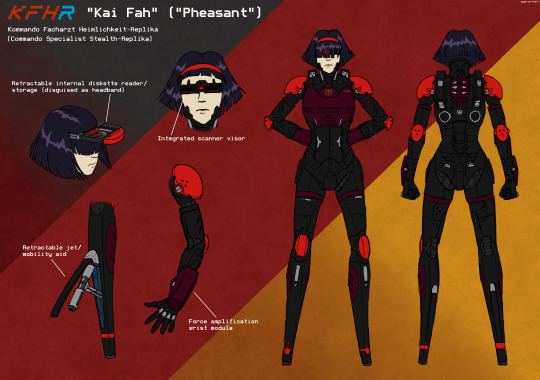

KFHR was a limited run of Generation 5 Modular Intelligence Specialist Replikas, designed as spies compatible with a number of different materiel and computer interface formats.
Kai Fahs boast a number of modular equipment connection points, but by default are serviced with a head-mounted disk tray, back-mounted sensor packs, bioresonant dampeners, two storage rails, and leg-mounted mobility aid jets. They were typically fielded deep within Imperial territory to perform intelligence gathering, but would occasionally engage in espionage, sabotage, and hacking operations. They possess innovative data processors and upgraded tertiary drive capacity, primarily used in data harvesting from enemy computers.
Though their bioresonant dampeners were revolutionary at the time, they were rendered obsolete by the advent of Generation 6 bioresonance technology in model series such as KLBR, which could resonate past these dampeners with ease. As the ability to partially mask itself from bioresonance was a major reason for the KFHR series' inception, this led to the premature discontinuation of their already-limited model. Kai Fah units have since been repurposed all across the Eusan Nation in a number of different roles - most prominently as substitute secret police and block wardens where the more expensive Kolibri is not feasible for posting. Remaining Kai Fah units are sometimes hostile to Kolibri units, blaming them for a perceived loss of purpose.
74 notes
·
View notes
Note
Hi! I’ve been trying to make an introductory post for my WoL, but when I tried doing so freeform it ended up overly long and full of rambling. I’ve searched for templates all over the internet, but the only ones I can find are in the general style of D&D character sheets that include irrelevant information about stats while not properly dedicating space to the actual character traits. I saw the format you used for your OCs, and it seems to be about what I’m looking for. Is there any chance you could provide a blank template along those lines for me and others who might have the same problem?
Funnily, while I keep them all similar, I didn't have a template before now. Also reminds me I need to do some updating and revision on my own OCs, it's been awhile and they can use a refresh for character and plot updates.
I recommend making static pages over posts; easier to track and edit. I am a stickler for organization, so keep my pinned post to the bare basics with links to the profiles and other pages, to keep from stretching the post to a mile long, in part, and to keep the info where it's easily read and relevant. Also because mobile app view won't show one's theme and links, and the pinned post is more likely to be seen and accessible than a sidebar or menu.
I have tutorials on how to set a custom theme (and access full blog features) as well as how to create those static blog pages. Tumblr may have made some updates since, but the gist is the same, and the Help pages have newer details if necessary.
I do urge keeping colors and format simple, accessible, and reader friendly, including screen reader friendly. A row of asterisks or tildes as a separator line are usually individually read out by screen readers, as is the code used to make those fancy hard-to-read gothic letters folks use for "aesthetics." In a lot of my profiles, I split sections with images of the character (which should also use alt text if we're trying to be kind and inclusive, and it's to the point of a profile page anyway).
I think I will put the intro and template here in the post under a cut, and then in a Reply Comment add a link to the Google Doc version, cuz of how Tumblr is about external links. An actual blank copy-pasta is on the GDoc, what's below has some thought processes for each section for guidance.
This a pretty modular template, that can be added to or subtracted from as needed. Move descriptive blocks around as they seem more or less relevant for your OC, substitute things that make sense over things that don’t; this is just a starting point!
I see these as broad strokes; a quick introduction and general overview of your character, meant to give an at-a-glance idea of who they are. It’s handy for other writers and artists, and even oneself for keeping track of some details. I recommend practicing succinct writing here; these blocks should each stay between 100-300 words or thereabouts. Use links to other pages and tags to point toward longer details and stories (and keep them handy for yourself!). It also makes it much easier when you want to revise things when characterization marches forward, or if you want to retcon something entirely.
But these are all just my opinions and ideas on how I approach OC profiles after making them in some form or another for about a quarter century. Make it as long or short as it needs to be, change it up, go nuts, I ain’t your mom, and so on 😉
-
Statistics: The basics; barebones, at-a-glance stat blocks, handy for quick reference. Can be added to or shortened as needed. If a stat starts to word wrap on a standard screen, trim it and move that extra detail to the “Description” paragraph below the list.
Race: (for FF14 fantasy possibilities) Nationality: (or Ethnicity, whatever works. Where are they from, as that helps shape them?) Height: (both feet/inches and centimeters are handy here) Eyes: Build: (I prefer this to weight, as that’s ridiculously variable depending on one’s build, which is more important visually anyway; are they broad, stocky, skinny, muscular, stringy, etc) Hair: (color, type, texture, preferred lengths and styling) Skin: (sometimes I fold scars into here, if there’s nothing too outstanding) Scars: Voice: (how do they sound?) Nameday: Age: (depends on your personal timeline for your OCs, but I recommend an age range over specifics; mid-20s, 25-35, late teens, a little over a century, etc. Less updating and fits with the handwaved time bubble anyway) Disciplines: (what are their main job[s]? The adventuring or professional skills they’ve learned?) Hobbies: Birthplace: Current Home: Occupation: (Their actual day job, different from or part of their disciplines?) Signature Items: (A particular weapon? A piece of jewelry? Always wear a specific coat?)
Description: A very short "immediate impressions" type description; what would someone "on the street" see when meeting/looking at your character on a typical day? Taking some of the info from the stats but then how you want those barebone facts to be seen; is the OC elegant, or rough? Expensive clothes or simple attire? Any particular smells, or sounds? I recommend around 100 words.
Biography: Very brief, general overview of the backstory that led them to the point where they become a story protagonist (adventurer, the WoL, or other roleplay archetype). Don't have to go into great detail, keep it short and simple; it's a blurb that sets up how they got here in broad strokes. I think my longest bio is around 300 words, and it probably shouldn’t go over that here.
To get more details, one can always link to specific stories, or to a tag. I have multiple OCs, so I might make my tags something like "Aeryn Backstory" or "Iyna Lore" or "Punchy History" or some combo thereof (I usually try to keep them consistent though for ease).
Persona: What face do they present to the world? How are they perceived by the public, acquaintances, coworkers, family, actual friends? Some of these answers will be the same, some may change depending on if and how they code switch in various social situations.
From there, what lies underneath the surface? What are some general internal attitudes, traits, feelings?
A hundred words for outward demeanor and another one hundred for innermost self ought to cover the general broad strokes.
Romance: If so inclined, details about the OC's relationship details; sexual and romantic orientations, relationship history, current situations, how they view and approach intimacy (or not!).
Links to relationship tags or stories or art can work well here, too.
Echo: Does the OC have an Echo at all? Is it a "typical" Echo, or do they have some special abilities, some things they're better at than others? How does it affect them, how do they feel about it?
This is another section that may be a free space section to remove or swap to something else relevant to the character.
Hobbies: The stuff outside of work and heroics. Ways they relax, special interests, side jobs, things they enjoy, and so on. This can be an expansion of the listing in the stat block, or you can cut out one or the other to avoid redundancy.
Companions: What’s their chocobo like, or do they have another favored mount? What pet(s) do they have? Are they practically a Disney Princess? Have a familiar? Do they prefer arcane entities? Technological constructs? Or do they eschew companions entirely?
How to find the OC in game: This is where I list things like realm and data center, and addresses for the FC house and personal house or apartment. Not necessary if you don't want folks to go looking.
Links: The links can be scattered through the post in relevant sections, or gathered together here. I tend to put my basic tag for the character, if I have an aesthetic tag for them, their story tags, any links to art references or other miscellaneous items I want easily found for myself and others. I often put this close to the top if a profile is longer and I want those links to be quick referenced.
OOC: Any particular notes one wants to make about the character from a meta perspective. Can also be combined with the Links.
32 notes
·
View notes
Note
The body the corrupted core chose was one that kept it's original form, but allowed him much more mobility. A simple, deeply buried design that was attributed to someone named Keith Astor. The core had indicated to the AMA its location within the files of the large, mazelike systems Aperture ran on... And judging by the software inside the core, he had some knowledge of who had created the files.
It had been a visionary piece. Not all of the materials were even available to AMA... But of course, it likely did it's best. Recplacing and substituting wherever it couldn't do the exact job the schematics entailed.
And finally, the core was able to be released from the chamber on the plate, unsteady and barely calibrated. He leaned against the wall for balance, the optic in his head spinning and blinking slowly... He'd kept the main body of a core for his head, minus the limiting handles, and his body was a slightly modified version of the regular models of this time.. Though it was much more modular... Whoever had made it had done so with the ease of modifications in mind..
He felt as if he were biting his tongue, anxious to speak for fear it would still come out wrong.. He hadn't spoken a word of sense in decades, it was perhaps only fair that he were tense...
@adventuregunsphere
The A.M.A had looked over its work. The arm it had used was seemingly a bit tense itself as it tried to analyze what it had done. It was unable to be exact with the schematics provided to it, so it wasn't entirely happy with how it came out. It wasn't perfect.
Nevertheless, it tried to push this aside. It did its best with what it had. The parts for this model were outdated afterall...
[Please proceed with caution; calibration has not been sufficiently completed.]
It watched quietly afterward. What could it have done better? What substitutes should it have used that would have been closer to the original blueprint? What if its estimation caused any errors or discomfort? It would not know. Not until the problems were found. So it sat in unease, anticipating a major flaw.
113 notes
·
View notes
Text
Project Metamorphosis was the Space Pirates' way of preserving their commanders, keeping them alive through technology, and most importantly, keeping them operational; With cybernetics, any leader would be able to continue leading the Space Pirates in both tactics and even battle, no matter how damaged their organic bodies were.
Those submitted to the process were Space Pirate commanders injured by Samus Aran during her first assault on Zebes; Ridley, Kraid, and Weavel. Kraid was given a cybernetic dome over his face in order to protect his recovering eyes and see for them, but otherwise his adjustments were minimal. Ridley replaced a good portion of his body, and Weavel? He ended up replacing everything except his brain and spinal cord, much to his chagrin; His injuries were much more extensive, and unlike Ridley, he lacked any regenerative abilities.
But Project Metamorphosis was not just about giving Space Pirates cybernetic prosthetics; It went further than this. Hence, Mecha Ridley; At first glance, it seems to just be a robotic doppelganger of Ridley. And indeed, one of its functions was to act as a complete set of cybernetic prosthetics for the Space Pirate, meant to represent any possible limb or organ he might lose. This is quite common as a medical practice, although the full set of prostheses being programmed to attack intruders on their own isn't...
If Ridley were to lose an arm, an arm would be taken from the mecha and applied to Ridley's injured stump. If his face was burnt off, the skull chassis would act as a mask. Fire-breathing organs could be substituted with an internal flamethrower. The modular nature of Mecha Ridley meant that if Ridley replaced his hand, only to lose the rest of the arm it was connected to, the arm taken from his Mecha counterpart could still reconnect with the robotic hand he was currently using. In essence, Mecha Ridley was the precursor to the Meta and Proteus frames, hence the missile-launching booster as less a replacement and more an enhancement.
But Mecha Ridley had another function as well; Acting as a machine with which Ridley could project his own thoughts into, and control from afar. For in order to move the body, the brain sends signals through the nervous system, which the limbs and organs receive, and then interpret to move accordingly.
These signals are electric in nature; And so are wireless signals in technology. Through Project Metamorphosis, a neural interface could be applied to Ridley's head, and receive the signals he'd attempt to send to the rest of his body, replicating and redirecting them to his robotic doppelganger. Mecha Ridley would receive his brain's signals instead, and as a result its mimicry of Ridley's limbs would move, while his actual arms -if they were even present- would not do anything.
Mecha Ridley would also absorb visual and auditory input, directing it to Ridley, who would receive it via a VR headset. It's like a simulation, except your ‘avatar’ is in fact a tangible replica acting elsewhere. This feature is useful if Ridley or any other commander is so damaged that they can't even function on the field as a cyborg. In Ridley's particular case, it's to give his true body room to regenerate without having to worry about cybernetics restricting cellular repair, while also allowing him to fight 'on the field'. It's the best of both worlds.
...The problem with this form of cybernetic projection/possession is something every gamer fears; A bad connection. The Space Pirates worked to perfect the bandwidth of Ridley's neural headset and his mecha. But if Samus were to find herself unable to destroy a fully-completed Mecha Ridley, she could get around the problem entirely by interfering with the signals, causing the mecha to move one step behind Ridley, while Ridley received its input too late.
In case of this scenario, the Space Pirates programmed Mecha Ridley with its own independent AI to control itself with, should it stop receiving reliable input from Ridley in the heat of battle. So when Samus encountered it aboard the mothership, despite not being complete, Mecha Ridley still had a functioning AI to attack Samus with. Because this encounter happened so quickly after Ridley's defeat in Norfair, he hadn’t yet been resuscitated and hooked up to the neural interface. But in a future scenario, where Mecha Ridley was rebuilt and actually completed, it might've been something Ridley begrudgingly used while recovering from Phazon withdrawal and atrophy after the destruction of Phaaze.
Otherwise, he would avoid it if he could, and even subject himself to painful cybernetics as necessary; Ridley did not appreciate having a machine clumsily interpret his own moves for him. It was a distant, out of body experience, when Ridley preferred to fight in-person and experience death and destruction through his actual senses. Nevertheless, he kept the mecha on his personal ship; In Ridley’s off-time, he would put on the headset and test controlling the machine, so science team could see how to sync the mecha to his brain signals.
Since Project Metamorphosis could help Space Pirate commanders 'transcend the body', this same principle was applied to Meta Weavel. Despite Weavel being a Zebesian, his mechanical frame ended up having a noticeably different form, more upright and humanoid. The idea was to build off of Mecha Ridley by seeing how a brain could acclimate to a body very different to the one it was programmed to control. Hence the project’s name invoking the natural process of transformation and rebirth into something radically different; After a vulnerable workshopping period, of course.
Despite Weavel's frustrations over the differences, he did eventually adapt, and his Meta frame proved to be of sufficient quality. Thus, Meta Weavel would be deemed a success; It showed potential for brains to adapt to a wider variety of foreign shapes. So for example, a humanoid brain could be made to operate an arachnid body. Or a serpentine brain could now handle a body with several limbs, when such a brain wouldn’t even have neural pathways for this.
But the cybernetics could be made to interpret and ‘translate’ the brain’s signals, meant for a different body, into movements corresponding to limbs not alike. There have already been implants that translate the pheromones of species that communicate via smell into sound, and vice-versa, to aid in cross-species interaction; All of this is the natural extension, the natural evolution, of such technology. The Space Pirates would have to test more extreme examples like these, intensifying the disparity with each success.
And the goal was to combine these results with that of Mecha Ridley, to create technology in which a Space Pirate could telepathically control and 'possess' a mechanical body wildly different than their own. Project Metamorphosis would be taken even further from there; Perhaps being used to upload minds into machinery, allowing them to interface with data and become it, etc.
It could even lead to a telepathic possession and control of technology, with Mother Brain already being this; In fact, she helped form the inspiration for Mecha Ridley (so in a way, Zero Mission’s final boss is a culmination of Mother Brain, Ridley, and Weavel’s command). During her stint as Space Pirate leader, she permitted some study of her schematics by Project Metamorphosis scientists.
They analyzed Mother’s power to telepathically control both machines and even living organisms, in the hopes of replicating this with headsets and corresponding receivers; Science team hoped in particular to implant receivers into anyone or anything, without needing permission. Imagine hijacking a body by cutting off the signals from its host brain, so it would instead receive signals from another remote brain entirely.
Imagine bypassing the need to implant physical receivers entirely, and just using brainwaves and telepathy to disrupt a body’s natural signals and replace them at will! Imagine replacing them selectively to brainwash someone, letting them handle the rest as they obey and interpret on their own a basic command, freeing up brainpower to use in other processes or thralls!
All of this is how Mother Brain’s telepathic control works; It enabled her to control the Metroids, especially since she possessed Chozo DNA that the larvae were still programmed to obey. And it helped Mother Brain take command of technology as she saw fit, even sometimes controlling her Chozo charges for them so they could just let their minds and wills rest.
It allowed Mother to influence Zebes’ ecosystem and make it hostile to all outsiders. Her job has always been to do the thinking for people, after all; She is their new brain. Mecha Ridley is just the natural evolution of cybernetics interpreting for regular body parts the brain’s signals; Mother Brain’s conquest is just the natural evolution of her own programming, which she hijacked for herself to no longer be made to control, but to control under her own volition.
18 notes
·
View notes
Text
Fashion & Decadence Culture

Fashion is notable on Azil as it is elsewhere, with different groups and cultures having long (or recent) traditions and recognizable styles that are unique to them. On average, modern collective preference wavers between comfortable and practical, to sleek and fashionable, but ever an emphasis on personal expression. Outside of unique places or events, it’s considered rude to judge an individual for their preference of clothing unless it infringes on cultural customs or the comfort of someone aside from the wearer, such as flashing lights in dark places or massive accessories that crowd others. While the exact rules are an understood concept that varies in social settings, the style, color and way one dresses is meant to evoke an idea of personal honesty and feeling, thus any number of fashions can be found in large cultural centers.
Buckles, bags, gadgets, blinkers, baggy pants with a form fit top–in a general sense, neon cyberpunk and eco-future-punk are the go-to ideas for average sensibilities. Runners can be seen sporting any number of athletic-minded modular fashions (zippers are as common as pockets), often in their signature colors, and bots are dressed to show off their mods or patterns in a tasteful manner.
As for formality, suit-and-tie fashion managed to worm its way back through convergent social evolution despite the knowledge of it being lost to history. Crisply ironed shirts and slacks with vests, ascots, chains and coats are considered “black tie” wear, though with certain notable differences from earth’s staple code. Neck decorations are common substitutes for jewelry, with ties being either silk or fractals.
Suit wear, also sometimes referred to “decadence wear”, is not limited to men. While dresses are considered peak femininity to match the pants and tunics of masculinity, cultural variance blurs the lines between men’s and women’s fashion. In Arrimask, skirts are considered high fashion for both sexes with pants also being used by both to facilitate work and comfort; layers are their main take away, with the absence of “workers hems” (pants) being a sign of wealth and status. Many arid locations also use sheath wear and flowing fabric for comfort, thus pants are considered decorative and fashionable as they denote the lack of necessity outdoors where circulation is required to be comfortable. Meanwhile, working class folks favor pants cut loose for mobility and wraps that hold air for carrying and cold weather. To the Weslans, the pants and vests are stern and cut a silhouette they appreciate for matching their formal, direct and militarized system, usually in pristine whites for active duty individuals which mirror their fatigues which are often blacks and dark blues.

A language evolved, as it does, in certain mixed social settings in regard to formal attire not unlike fan culture on earth. Following the “average” rules that are obeyed in all cases where the event is not tied into cultural heritage, these habits popped up in regard to self-expression, intention and other details based on one’s preferences in dress:
The base color means less than the accent colors; a base color is generally flattering but how they choose to accessorize and with what hue is thought to be an expression of personal taste. Warmer hues are welcoming and cooler ones denote a formal attitude.
In cases of suit wear styles, straight cut pants are worn for business and formality while shaped, belled pants with loose bottoms are playful and friendly, welcoming approach while the straight-cuts wish to be the one approaching.
The flamboyance of the attire versus the event is used overall to judge one’s persona with extravagance equating to self-confidence (or self-centeredness). In general gatherings, anyone is welcome to dress however they wish, but in cases where there is a centerpoint patron (weddings, celebrations, birthdays, etc) it is considered extremely rude to upstage them.
Men’s suit wear coats take after trenchcoats, favoring long tails and patterned inside linings while women’s often have bustles or waist trims. Coat length is a mark of formality.
Attached hem-extenders are occasionally used on menswear when coats are too formal, which they then use in the same manner as their coattails. Sweeping a hem between himself and another is a dismissal or disapproval while sweeping it away is an act of welcome; holding the coat end up is akin to holding a door, permitting the one at the “entrance” to approach. Turning quickly or otherwise making the coattails flutter when departing denotes displeasure and a “removal of footprints”, acting as a “do not follow me” marker. Not “sweeping” the floor leaves an invite to pursue or interact later on, particularly if conversation was favorable.
Men who favor shoulder cloaks over coats apply the same techniques.
For women, extenders go on the cuffs, acting as long sleeves they use in similar fashion. Hiding their faces behind their sleeves is an act of coyness but also of privacy, insisting on their conversation not be listened in on. Flicking a cuff hem is a dismissal of topic but balling them into the hand is a withdrawal from interaction; men are expected to back off if this is done, as it equates to “hiking one’s skirt” to cross a puddle. Sweeping one’s arms wide and allowing the cuffs to flow open is a welcome gesture of approach; if the cuffs are then picked up into the hand, it is a sign of engagement and to not be disturbed. Cuffs left to hang means “interaction welcome” even if the wearer is already involved with discussion. Bringing the hands together in such a way that they are covered by the hems is a polite dismissal of interaction or end of a conversation where either party may disengage. Hands left together in this way when attempting to approach is a hard ‘no’ to the approacher (visible hands is an invitation to talk).
For women favoring dresses, scarves or elegant sleeves are used for the same effect.
A lack of hem extensions removes this communication method and default to the ‘straight leg’ rules.
In formal gatherings where connection is favorable (mixers, company parties, galas, etc) it’s not uncommon to bring “favors”, which are as simple as silk cuts that match the accent color of one’s attire or other such things that act as tokens of interest. The context and meaning of receiving one is heavily dependent on the gathering and discussion held, but generally equate to an invitation to get together after the event ends. Business cards are the most common as they hold contact information that can be used at any time, but other favors are used to request company after the main event or even to “exit” together which can be a declaration of interest and visibility (i.e. if you’re seen leaving together it can be quite a scandal or subtle way to imply business ventures or courting). The return of a favor at any point is a rebuke of attempted affection or the desired deal.
In some cases, it’s considered a game to see who can pass a favor without drawing attention, leaving them in pockets, the palm or otherwise attached to their receiver. Adding up favors after an event is a bit of fun for school-age individuals.
This “speaking with motion” culture arose to save face by not drawing attention with yelling. It is considered extremely impolite to invalidate a silent command (don’t follow, drop the subject, etc) without good reason and to cause a scene (yell, cry, etc) is viewed as poor taste/low class. In most cases where there is not an obvious reason to do so, the one causing a fuss will be seen as the aggressor for their shameful behavior, thus it helps to keep everyone on their best behavior to know (sort of) that causing a scene when insulted or rebuffed will not win them any sympathy. (This doesn’t always work but generally it’s understood that way).
The host retains the right to dismiss anyone for any reason and is exempt from the “causing a scene” rule, as part of the host’s duties is to maintain harmony, levity and safety during the event. Sometimes that means publicly shaming someone.
Levels of formality (the minimum level of dress required):
“Tieless” is the least formal kind of party, equivalent to “dress casual” where one dresses well but without adhering to decadence policy.
“Button formal” necessitates a dress shirt and slacks but is otherwise considered informal. Accessorizing is minimal. Button formal is considered appropriately minimal for holidays and birthdays or social gatherings.
“Vested” or “three-cut” is the most common level of formalwear, requiring a nice shirt, vest and slacks; “three cut” is taken from the idea of each piece being tailored to the wearer and to have three pieces in a set is “classy”. Certain exceptions exist for cultural garments and most will equate standard formality for that group to this level. Substituting waist cinches or corsets for vests, blouses for button ups and skirts for slacks is acceptable; long skirts are less common than short ones, with knee-length being the average. Long socks or leggings/tights are considered classy and clean as opposed to bare legs.
“Covered”, “coated” or “pressed sleeves” is a fancy affair that requires a coat, shawl, cape or other outer covering. Attendees can accessorize as readily as they wish, and while coats may not remain on (sometimes they are taken to keep them safe, particularly at dinner parties) having one is the expected minimum. Short hems are the norm with extensions often used during social hours if coats are not kept. Wearing full hems to a coated event is considered extravagant. This is the most common “high formal” kind of event (high formal means having a full outfit: shirt, pants, vest and coat).
“Cotique” or “gilded” is the highest formality with emphasis on socializing. Accessories are in full display and coats/hems can be worn full-length as they are expected to be used extensively. Many of these events do not have full dinners, relying on small eats and drinks throughout the night to avoid discarding the overcoat. At one time these gatherings were more common but now they are special events, often put together by niche groups (think of ballroom dances) or for certain social gatherings of high society.
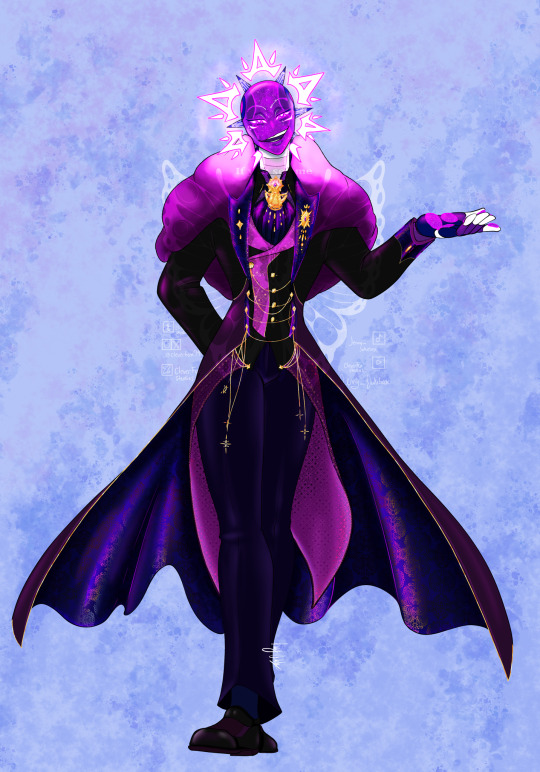
Substitutes/exceptions:
Blouses can be swapped for button shirts; corsets or waist cinches can be substituted for vests; skirts can be substituted for slacks.
Capes can be substituted for coats.
Short coats equate to single-shoulders
Long coats equate to full-shoulders
While it is not forbidden to hide one’s face, “masquerade” does not exist as we know it. Adding a layer of mystique, a masked individual often does so for privacy. In high formality events, masks are worn by security to “hide” them and not distract from the event, thus a guest wearing one is both suspicious and alluring.
Likewise, gloves are a form of communication tool. Wearing them at high-formal events acts much like straight-cut pants and can be used if one is wearing bell hems but prefers minimal interaction or a form of difference. The pants say “greet me, I am friendly” however the gloves prevent assumptions, acting as a barrier to the interaction. Dancing with gloves is shorthand for “this is merely out of politeness” and not to be taken further; parent-child dances, friendly dances, etc, are gloved. Gloveless dancing is considered more intimate, implying a desired connection, though this has fallen out of favor in modern times for being “too much”. Nowadays, gloveless dancing is the norm while gloved dancing is seen as unusual but retains its original meaning, as instead of attending with gloves already on, one would put on the gloves as a deliberate act of intention.
Cultural clothing and mannerisms are to be treated with respect and in cases where formality is not known, it is considered polite to ask. What is not polite is to call into question the taste of the wearer or insinuate they are low-class for having different standards than oneself (though it still happens).
Ball gown dresses act as entire ensembles for the “vested” look with shawls, scarves or certain coat styles acting as the gilded level coat requirement. Generally speaking, the eye-catching manner of dresses is usually reserved for hosts or guests of honor so they are easy to pick out in the crowd but this is usually noted in invitations that dresses are not permitted for these reasons.
3 notes
·
View notes
Text
Why the Low Voltage Switchgear Market is Booming in 2025?

The low voltage switchgear market is growing rapidly in 2025 due to growth in electricity consumption, development of intelligent devices, and a strong emphasis on sustainability. Energy efficiency, digital transformation, and security are critical for industries and businesses, which leads to a high demand for new, robust, and intelligent switchgear. This article will discuss key drivers of market growth, emerging trends, and their impact on businesses and industries globally.
1. The Growing Demand for Electricity
Over the past few decades, the increasing demand for efficiency in power distribution systems has become ever imminent with the rise of general energy consumption. Rapid urban expansion, industrial development, and the emergence of data centers have been some of the major driving forces boosting the demand for low-voltage switchgear.
Global Electricity Demand on the Rise:
· The IEA projects electricity demand in developing nations will rise at a rate of 4% each year, as consumption steadily climbs.
· Data facilities and cloud computing require relentless power sources, amplifying the need for resilient switching equipment solutions capable of sustaining operations.
· The proliferation of electric vehicle charging points is compelling utilities to renovate distribution networks, ensuring functionality can accommodate increased demand.
Modernization spreads as industries broaden their scope, making electrically-reliable infrastructure an imperative; low voltage switchgear has become integral to conveying energy throughout the grid in a secure and effective manner.
2. Smart & Digital Switchgear: The Industry’s Future
Traditional switchgear technology has evolved rapidly with the integration of intelligent networking capabilities, making electrical distribution safer, more efficient, and easier to monitor remotely. The new digital switchgear incorporates IoT, AI, and cloud-based monitoring solutions to provide real-time insight into energy usage. This allows businesses to proactively optimize performance and reduce costs through more proactive maintenance strategies.
Major Developments in Intelligent Switchgear by 2025:
✅Online Sensor Networks: Constant telemetry from devices throughout the system helps pinpoint potential weaknesses before failures occur.
✅Self-learning Circuitry: AI-powered hardware and software automatically analyze usage patterns to forecast repairs, minimize outages, and heighten uptime.
✅Wireless Remote Management: Mobile apps and web dashboards give administrators off-site control over power flows to streamline usage according to need.
✅Modular Construction: Interchangeable, compact components facilitate scaling and retrofitting within varied infrastructure environments.
The shift toward automated smart grids and Industry 4.0 production is substantially contributing to the booming market for intelligent switchgear solutions. Widespread installation of these next-generation systems will transform electrical distribution networks.
3. Rising Emphasis on Energy Efficiency & Sustainability
Governments and industries worldwide have increasingly pushed for greener, more energy-efficient power solutions in recent years. This has led electrical equipment manufacturers to develop eco-friendly switchgear technologies that considerably minimize energy loss during transmission and help reduce overall carbon footprints.
Sustainable Advancements in Low Voltage Switchgear Design:
Alternative gases to SF6: Traditional switchgear commonly uses SF6 due to its insulating and arc-quenching capabilities, however this gas has an extremely high global warming potential. Many switchgear producers have since designed SF6-free solutions that substitute the highly potent SF6 with other gases that are safer for the environment.
Energy-Efficient Designs: Optimizing circuitry and components has allowed switchgear to conduct electricity with negligible power loss, enabling connected systems to leverage nearly every watt of power. Careful engineering further trims excess material use and redundant parts.
Renewable Energy Integration: Low voltage switchgear has become increasingly vital in smoothly and reliably integrating power from solar arrays and wind farms into existing electrical networks. Without robust switchgear management, it would be difficult for clean energy sources to efficiently feed power onto transmission lines.
With the implementation of more stringent energy performance mandates in countries worldwide, businesses have sound business reasons for upgrading outdated switchgear infrastructure with advanced low loss solutions both to adhere to regulations and lower long-term energy expenditures.
4. Increasing Investments in Infrastructure & Industrialization
Governments and private investors alike are pouring billions into ambitious infrastructure projects around the world, generating skyrocketing demand for reliable low voltage switchgear solutions. From towering commercial skyscrapers to sprawling industrial complexes, and expanding metro networks to bustling international airports — countless utilities depend on robust yet cost-effective switching systems to ensure continuity of operations.
🔹 Key Infrastructure Drivers Stimulating Growth:
🏗️ Smart Cities Uplift Life: Sweeping investments in digital urbanization are revolutionizing everyday living through connected infrastructure that elevates efficiency.
🏭 Manufacturing Marvels: Production powerhouses across the globe are scaling new heights, intensifying the necessity for advanced low voltage distribution controls to support increased capacity.
🚆 Transportation Transformations: Rapid progress in rail electrification and proliferation of electric vehicles for land and air are necessitating increasingly resilient switchgear designs.
As global development marches forth, low voltage switchgear has become mission critical in enabling commercial and industrial progress through reliable power distribution. The worldwide infrastructure renaissance is cementing its importance for years to come.
5. Safety & Regulatory Compliance Are Driving Upgrades
Governments and regulatory bodies are increasingly implementing strict compliance standards to safeguard electrical infrastructure and minimize hazards, compelling upgrades across many industries. Potential calamities resulting from power faults or failures necessitate vigilance in maintaining reliable and resilient systems.
New Safety Regulations in 2025:
⚡ Updated IEC & NEC Standards: Stringent low voltage switchgear specifications mandated to bolster protection.
⚡ Arc Fault Protection Technology: Novel solutions critical to curb risks of electrical ignitions and incidents.
⚡ Mandatory Energy Audits: Organizations now required to optimize distribution for both personnel and operational efficiency through audits.
With approaching deadlines to satisfy evolving regulations, operators are proactively replacing outdated switchgear to conform with mounting compliance demands, contributing to an accelerating industry transformation.
6. The Rise of Data Centers & Digital Transformation
The digital sphere fundamentally relies upon data hubs that necessitate constant power and exceedingly reliable electric frameworks. As distributed computing, man-made brainpower, and IoT reception develop exponentially, ventures are putting vigorously in cutting edge low voltage switches to ensure their foundation from energy blackouts which could bring about gigantic budgetary misfortunes.
24/7 control is essential for operations yet breakdowns prompt critical money related setbacks. To guarantee uptime, focal points utilize auxiliary switches for extra dependability and security alongside far off checking abilities through IoT innovations which empower ongoing following and administration from anywhere. With worldwide distributed computing selection quickening at a quickening pace, interest for top notch low voltage switches arriving at new statures to guarantee frameworks stay online consistently.
7. Competitive Market & Technological Advancements
The low voltage switchgear sector has seen remarkable changes and fierce competition between prestigious brands. Manufacturers are pouring resources into innovation to craft smarter, smaller, and affordable switchboard alternatives.
🔹 Notable Advancements by 2025:
⚙️ Solid-state systems promise enhanced performance and lessened upkeep. Long and compound sentences mix with short ones.
⚙️ Remote accessibility through wireless means permits control and tracking from afar.
⚙️ Self-mending grids using AI to immediately spot and amend problems, maintaining dependable power seamlessly. Complex automation alleviates faults autonomously for maximum uptime.
Conclusion: The Future of Low Voltage Switchgear Looks Bright
Low Voltage Switchgear is forecasted to experience market growth in the year 2025 due to the growing electricity consumption in countries, the rising applications of smart technologies, the increased implementation of sustainability practices, the expansive growth in various industries, and safety regulations. As these industries are gradually moving to energy-efficient, AI-powered, and environmentally friendly switchgears, this demand is expected to increase further.
5 notes
·
View notes
Text
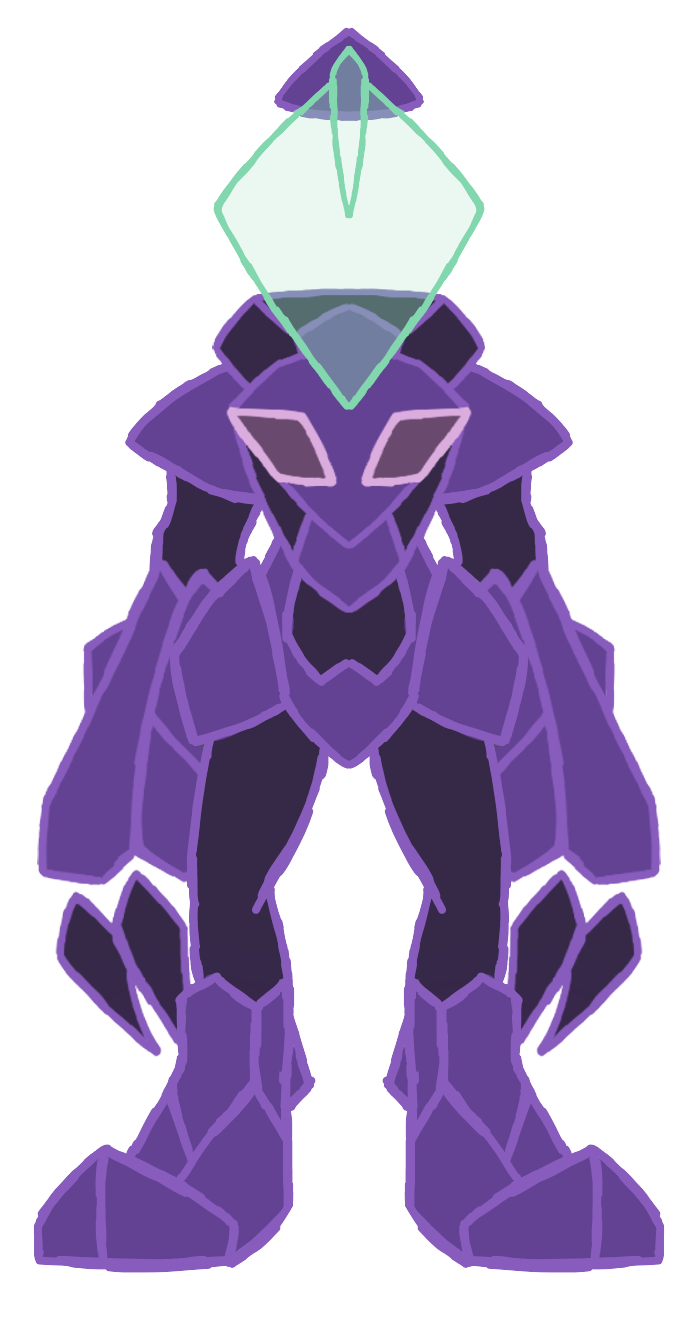








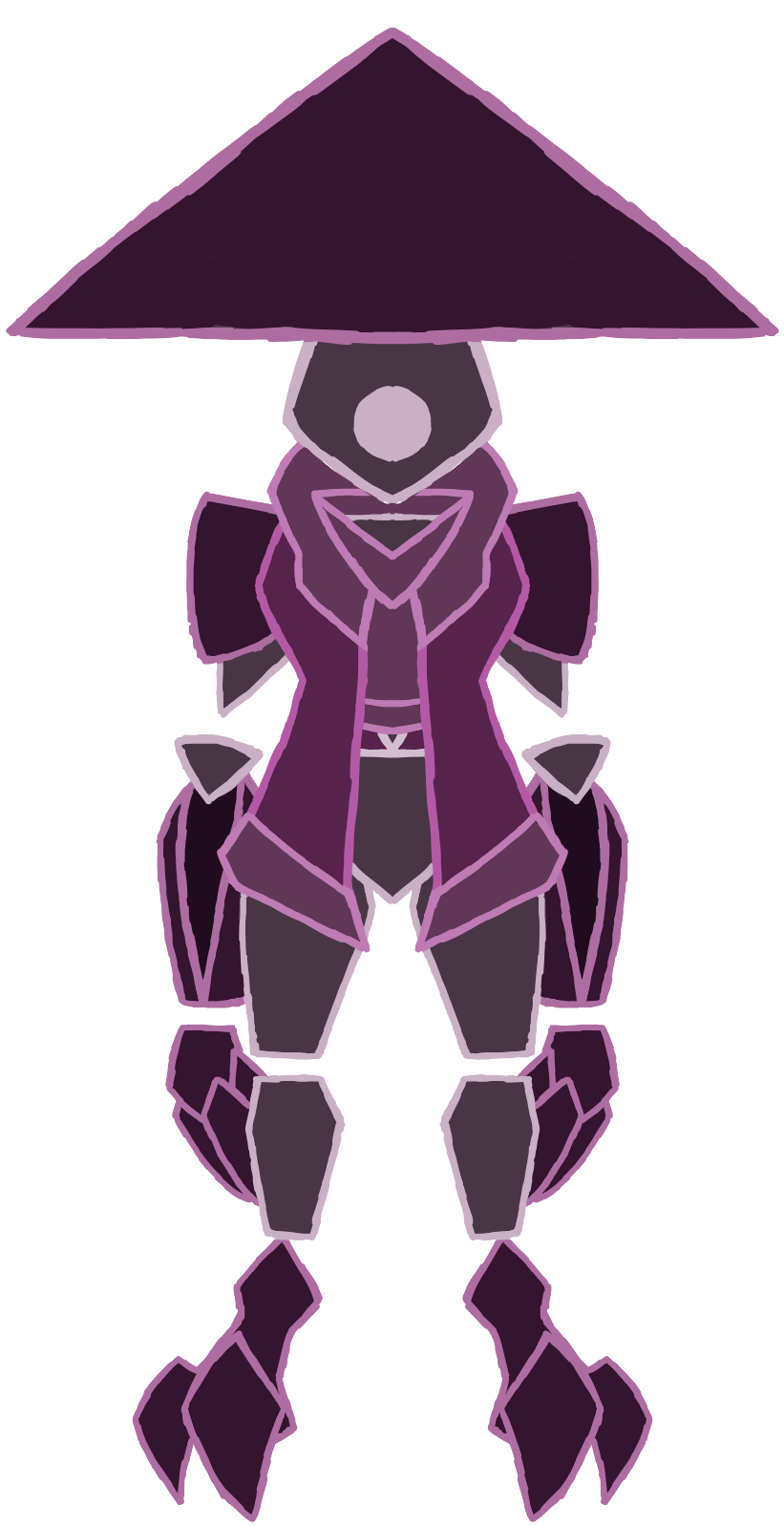




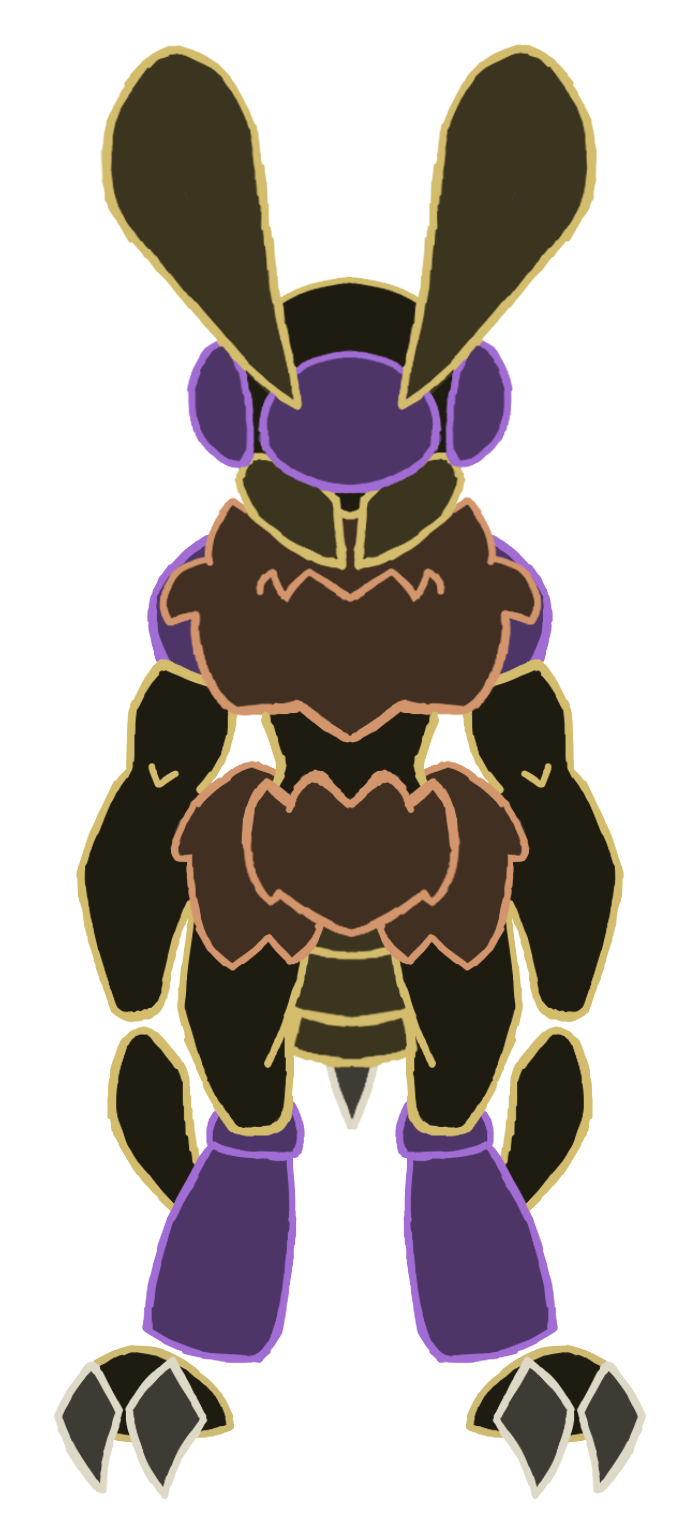


I FORGOT BUT I ALSO MADE THAT DATABRAWL SPORE CROSSOVER THING SO HERE'S SOME OF MY CREATURES
Tiny lore blurbs under the cut
FLORAWALL/GROWTHSCULPTS
These guys are maethrai tree golems that Foxtrot made while researching plant based cybernetics. They're modular in a sense where the torso and head are their own entities. The head of both the ent and the standard are actually Growthsculpt bytes that have linked with a Pitcherlog Torso.
CHELONIWARE/TERRAWARE
This species of malware are reptile/turtle like. They spend most of their days mining and blacksmithing tools, armor, and jewelry. Like the viruses of the Maethrai network, they evolved away from needing program hearts to survive.
VYCELIUM/VYSHROOM
The viruses of the Maethrai network evolved away from their violent ancestors after Healiebees provided an alternative to program hearts. These mycelium variants of virus compost detritus into fertilizer, and in general do um.. mushroom stuff I guess?
PHAETHONTI/ PHAEGRAM
The original computer of the Maethrai network used to be a normal computer..yet one that was slowly dying out due to the conquest of corruptions. That was until the Healiebees and Hareballs arrived. With the Hareballs they brought life into the dying computer. They brought Maethrai trees and other flora. With the Healiebees, They brought medicinal honey that the corruptions could substitute program hearts with.
HEALIEBEES
Healiebees are a species of insectoid bee known for their honey. How they arrived to the Maethrai computer isn't exactly known. The regenerative properties of this honey is sought after for medical use. If you were to say, lose an arm, Using this honey would allow you to regrow the lost body part. It can have some other effects if microwaved or mixed with other substances. Healiebee honey can also be used as an alternative to program hearts.
HAREBALLS
Hareballs are a species of plantoid similar to that of hollygrams. Like the Healiebees, they have a similar air of mystery to how they came to be. This species of plant seem to boost the ecosystems they're in. Similarly to how a luckyclover boosts other corruptions. These fluffy creatures may not be the brightest, but their terraforming abilites aren't to be ignored. With enough of them, you could turn a desolate wasteland into a lush landscape teeming with potential.
#dataspore#databrawl#crossover au?#threes not really any conflict in this au because this is kinda just a comfort fic type deal#its like a utopiboard but TRULY a utopia#except for normal firewall#healiebee#hareball#vycelium#terraware#phaethonti#maethrai
19 notes
·
View notes
Text


screwstyle cast resin, steel 2025
In screwstyle, the human form is reduced to a modular unit, a translucent green head mounted at the edge of an industrial bracket. The figure is not supported but fastened—treated less as subject than as hardware, a part to be slotted into function.
There is no subject here, only a remainder. The bracket does not support—it integrates. Flesh becomes interface, cognition becomes lag. This is post-organic ornamentation: ornamental meat screwed into steel, vibrating with low-level system error. The spiral thread isn’t a symbol, it’s a protocol—rotation as logic, fixation as ontology.
Identity is not erased; it is reformatted. screwstyle diagrams a world where all resistance is pre-coded, all individuality slotted into infrastructural recursion. There is no outside—only mounting hardware.
This piece continues my investigation into the aesthetics of control, substitution, and the slow violence of integration. screwstyle is not a narrative object, but a condition—where identity is not lost, but standardized.
1 note
·
View note
Text

Full Name: Tuesday Gears MK 2
Nickname: 2, Tue
Jobs: Blue Mage, Black Mage, Summoner, Sage, Botanist, Miner, Fisher, Culinarian, cleaning maid, scribe, screen reader, research assistant, Chuu’s Boring Tasks Substitute
Gender: …? (He/Him)
Race: Anima core. Visually Viera
Age: probs like 6 months-1 yr (Mentally a young adult: physically only had a soul/consciousness for about a year.)
Origin: FC House
Religion: Only sometimes prays to any of the 12, dependant on what the situation is, tends to favor prayer to Nald’Thal, Menphina, Byregot or Halone.
Sexuality: Talia 💖🥰 also. Bisexual, gender plays a role in his attraction to potential partners. Demi-Romantic. Sometimes struggles to understand his feelings towards someone (trouble with differentiating platonic and romantic or even sexual feelings/attractions)
Relationships: Chuusday Gears (Master, Creator, Sister, Lazy Bum)
Haurchefant (crush)
Keathan [Husbands oc!] (Companion, Guardian, Co-creator)
Unique Physical Traits: Seemingly a real Viera toe to tip. Body is modular for repairs, the eyes can record and store video memory. Until Post ShadowBringers, weighs an absurd amount and cannot traverse easily in soft, muddy terrains or dense snow.
Likes: Travel, Sunsets and Sunrises, Orange, the smell of coffee brewing, Chai, Green, and rose Tea, clean/organized spaces, romance novels, running errands in new locales, Hot Cocoa, Snowfall, Ishgard
Dislikes: feeling useless/helpless physically, deep snow, water where you can’t see the bottom, Puddings (the Monsters), Ishgard, Hot Cocoa, strong emotions he can’t put names to or express
Can often be found: Wherever he’s needed. Chuu’s apartment, the workshop, Ishgard, traveling with Keathan, in the Alchemists Guild
Character Tags: #Tuesday Gears #FFXIV Tuesday #FFXIV Gears Duo <- for when it’s Chuu and Tue
Playlists: [Chores Simulator] <- Light piano, Small-town RPG themes, lil bit of Louie Zong

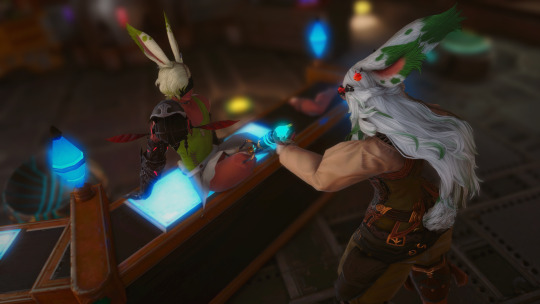
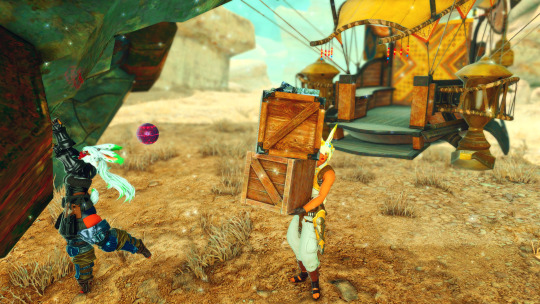
3 notes
·
View notes
Text
Supermarket Poke Bowls
For reference, it's been months since I wrote a recipe. This recipe has, by default, no raw fish, but you are welcome to prepare raw fish at your own risk to add. It also has rice, so I don't know if it's gluten-free. This is ultimately a modular recipe, so you can change out anything you like for other items, but this is my recommendation. Some items might be less accessible at an average supermarket, I'll mark them with an asterisk (*) to indicate them. Ingredients: Cooled/Leftover Sushi Rice* or white rice (short or medium grain) Cucumber Carrot (You can use shredded carrot if you don't wanna cut your own) Half an Avocado Pre-cooked tail-off frozen shrimp Smoked salmon (most packages at the store are pre-cut) Imitation Crab Meat (I used flake shape but stick/"leg" shape works too with some cutting) Optional: Pickled Daikon Radish* (there's not really any good replacements, but it's also an acquired taste in my experience. It's really sweet.) Optional: Nori* (Like the little snack seaweed stuff, seasalt flavour is probably the best in my opinion.) Optional: Toasted sesame seeds Optional: Sriracha* (I hear there's some kind of shortage? If you know any alternatives you can use that, but vinegar-based western hotsauce is not a good substitute here. You can also just not use it if you don't want spicy.) Optional: Japanese mayo* (Regular mayo also not a good substitute, but my local supermarket carries it at a cheap price recently) Sushi rice addendum: Sushi rice is of course the uncooked sushi rice, the water needed to cook it, and then cooking sake, rice vinegar, and mirin. I don't know the exact amounts you want for these things; for 2 cups raw rice i used 2.5 cups water and 1/3rd cup cooking sake, 1/3rd cup rice vinegar, and I think 1-1/3d cup mirin. (You can sub out any of these ingredients for equal parts the other ingredient, except maybe using all rice vinegar or all cooking sake.) I set it to boil, and once it reached a boil turned the heat off for 1 minute, then simmered it for 20 minutes. Then I folded in the mixture and let it cool- then I made sushi rolls with it, and used the leftovers for the poke bowl. TLDR: Cook rice as per instructions and if you have the stuff you can make it sticky rice by adding specific stuff to it. There are other alternative sticky rice mixes you can use on the internet too.
Equipment: Whatever you need to cook the rice (Rice cooker? Tall pot and stovetop?) A spoon or rice paddle Cutting board Paring knife/kitchen knife (Multiple, really) Spoon for avocado Bowl to serve in Instructions: Prepare rice as necessary (see above Sticky rice addendum) Cut cucumber in half or quarters length, then cut into thin paddle-like shapes (or just cut into julienne slivers, or however else you want to cut it)
Cut avocado in half, starting by stabbing it next to the stem and pressing the knife around in a circle around the pit. Then twist the hemispheres apart and remove the pit by chopping it with your knife to get it stuck on the knife. Afterward, remove the flesh from the skin with a spoon and place the flesh cavity-side down. Cut the flesh length-wise into slices. Cut the carrot into julienne slices or shred as needed; if you bought pre-shredded you can skip this step
If you have pickled daikon, cut it into roughly centimeter size cubes.
Thaw the frozen shrimp in the microwave for 15 to 60 seconds based on your microwave and the frozenness of your shrimp. Just cook until no longer frozen; maybe just in 15 second intervals. You don't want them to be hot, though.
Do any more additional preparation as necessary, such as cutting imitation crab sticks.
Add rice to the bottom of your bowl, enough to cover the bottom with at least half an inch thickness
Add your vegetables to your bowl starting with the cucumber at the 12 o clock position, and your carrot at 11 o clock, and avocado between them and yourself. Add the daikon if you have it at the 2 o clock position. at 1 o clock add the thawed shrimp, then add your smoked salmon at the 7 o clock spot, probably overtop the avocado. Then add the imitation crab at the remaining space.

From here, you can optionally drizzle the mayo and sriracha, shred the nori sheets up with your hands and place it in the center, then add sesame seeds.

Note: this photo features an additional ingredient that is not easily found, tobiko (fish eggs). It's a raw fish ingredient and I don't actually count it as a necessary part of the recipe, just decoration.
#recipe#modular recipe#cookbook#cooking#idk what else to tag this with#its not really sushi#poke bowls are popular ish now right#oh whatever#i felt proud of myself so i wanted to put this up here
3 notes
·
View notes
Video
youtube
Excellent Web Design Techniques for Designing Your Website
There is a proliferation of websites and, surprisingly, expecting you use the best Search engine optimization techniques and effectively direct people to you webpage it will be of little consequence except if your website is significant and really sticks out. If you believe guests should remain at your site, you really want to design it in a manner that is remarkable and uncommon.
Here are some advanced and excellent web design techniques you can use to create an engaging website.
• Use radiant colors in your website designs that can improve the visual allure. While concluding dynamic color plans you ought to permit adequate differentiation without however creating a shaking impact.
• Muffled colors are also an extraordinary method for creating an inconspicuous yet at the same time eye-infectious site. Blending in muffled colors in with a couple of more splendid or hazier colors can make your site design stick out.
• Numerous designers neglect to comprehend that Highly contrasting color plans can have a particular effect on your site. Using wonderful highly contrasting will make the site look generally graphic and business-like.
• Inclinations and lighting impacts might be tactfully used to give unobtrusive impacts. A muffled tone-on-tone inclination can make a charming background, Excellent Web Design Techniques for Designing Your Website Articles while slopes blended in with lighting impacts can create awesome header pictures.
• Grit is an incredible asset with regards to website design. Presenting unobtrusive grit elements can add flavor to the general design.
• Straightforward boxes can work ponders over very much planned backgrounds. Whether it is a photograph, sketch, or simple graphic elements, straightforward layers can give your background a significant thrust.
• Using larger than average kind can upgrade the significance of specific text elements. Some destinations even select to use curiously large typography for all their text however that might destroy the general design.
• Using enormous, striking background pictures is one more approach to creating the effect. By using easier designs, restricted or energetic color plans can deliver enchanted results.
• Brightening textual styles can be eye-appealing for however long they are not excessively lavish and simple to peruse. Using JavaScript and other text substitution devices to supplant the text with a picture in the ideal textual style make creating these impacts basic.
• Headers frequently briefly pass on the key data you believe that your site's guests should be aware. Using a header that is remarkable and engaging, competently adding color, pictures, and typography - will cause guests to wait on your web pages significantly longer.
• Composition elements are without a doubt some of the most flexible design choices. When used judiciously with clean edges, they can make a site look parcel more modern.
• Numerous experts propose the use of a touch of surface can add an additional punch to the background. As a matter of fact, there are finished and designed backgrounds aplenty and you can choose to suit the design needs of your locales.
• Selected route is demonstrated to be of more noteworthy benefit than button-or text-based route. Tabs look like note pads or covers and guests foster a mental inclination that tapping on a tab will take them to another universe of the unexplored world.
• Recollect that flat looking over destinations can be user-disagreeable and are best saved for locales with restricted content. When used alongside modular boxes and other substance elements, they can create an effect - yet keeping away from level scrolling is reasonable.
3 notes
·
View notes
Text
Top WPC Sheet Manufacturers in India You Can Trust
When it comes to choosing building materials that are durable, waterproof, and environmentally friendly, WPC sheets (Wood-Plastic Composite sheets) are fast becoming the go-to choice across residential and commercial construction. These sheets combine the aesthetics of natural wood with the strength and longevity of plastic, making them ideal for everything from modular furniture and wardrobes to wall paneling and exterior cladding.
India, being a growing market for eco-conscious and innovative construction solutions, is home to several top-notch manufacturers of WPC sheets. In this blog, we explore the top WPC sheet manufacturers in India you can trust, with a special focus on one of the most trusted names in the industry — Floresta.
Why Choose WPC Sheets?
Before diving into the list of top manufacturers, it’s important to understand why WPC sheets are gaining so much popularity:
100% Waterproof & Termite Proof
Low Maintenance & High Durability
Eco-Friendly & Recyclable
Highly Versatile – Can Be Used in Interiors & Exteriors
Excellent Substitute for Traditional Plywood
For homeowners, architects, and interior designers looking for performance without compromising aesthetics, WPC sheets are the smart choice.
Best WPC Sheet Manufacturers in India
1. Floresta – Setting the Benchmark in Quality and Design
When talking about the Best WPC company in India, Floresta is a name that stands out for all the right reasons. Known for their high-quality WPC sheets, the brand offers a wide variety of textures, thicknesses, and finishes that cater to the modern demands of furniture makers, contractors, and homebuilders.
Why Floresta?
Premium raw materials and manufacturing standards
Excellent product strength and finish
UV-resistant, waterproof, and fire-retardant WPC sheets
Strong dealer network across India
Trusted by architects and modular furniture brands nationwide
Whether you're planning kitchen cabinets, bathroom vanities, or outdoor panels, Floresta’s WPC solutions deliver unmatched performance.
2. Ecoste
Ecoste is another renowned brand in the WPC space. Known for its innovative approach to sustainable materials, Ecoste offers a comprehensive range of WPC boards and sheets ideal for residential and commercial spaces.
Highlights:
Environmentally sustainable products
Weather-proof and fire-retardant options
Used in cladding, ceilings, and false ceilings
3. Alstone
Alstone is a key player in both WPC and ACP (Aluminium Composite Panel) industries. Their WPC boards and sheets are popular in the interior design industry for being durable and easy to work with.
Strengths:
Good reputation for long-term durability
Wide product range with various sizes
Applications across office furniture, kitchen work, and exterior usage
4. WPC Doors
Although primarily known for their WPC doors, the brand also offers a solid range of WPC sheets. Their products are ideal for cabinetry, wall panels, and decorative applications.
5. Sehrawat Composites
Based in North India, Sehrawat Composites has been gaining attention for offering high-quality WPC solutions at affordable prices. Their product range is targeted at both small contractors and large-scale developers.

Why Trust a Reputed Brand?
Investing in high-quality WPC sheets from a trusted manufacturer ensures:
Longer product life
Resistance to swelling, cracking, and disintegration
Better surface finish for painting or lamination
Consistent supply and after-sales support
A brand like Floresta, recognized as a Best WPC company in India, combines product innovation with reliability, making it the preferred choice for top architects and builders.
Final Thoughts
With the rise in demand for waterproof plywood alternatives, WPC sheets are setting new standards in the Indian construction and furniture industry. Choosing the right manufacturer plays a crucial role in ensuring product quality, aesthetics, and performance.
If you’re looking for a name you can trust — for homes, offices, or retail spaces — Floresta continues to lead the way with its innovative and sustainable approach to WPC manufacturing.
Also, Read:
Why WPC Doors Are the Best Alternative to Waterproof Plywood Doors
Termite Proof Board in Delhi: The Smart Choice for Durable Interiors
0 notes
Text
The Role of Automation and Technology in Precast Concrete Manufacturing.

The precast concrete industry has long been a cornerstone of modern construction, offering speed, efficiency, and durability. But as the demand for high-quality, large-scale projects continues to grow, companies are facing increased pressure to deliver more, faster, and at lower costs. Even though they work, traditional approaches are limited. Technology and automation are more than just catchphrases; they are essential for prospering in a market that is becoming more and more competitive. Businesses that use cutting-edge technology are at a major advantage since it streamlines manufacturing, increases quality, and lowers prices.
For Modular Pulse, a leading name in UHPC factory consulting, automation is about much more than just upgrading equipment. It is about redefining the way precast concrete is manufactured. It is about leveraging technology to create smarter, more efficient processes that deliver consistent results.
In this article, we will dive into how automation and technology are reshaping the precast concrete industry and why now is the perfect time for manufacturers to take the leap into the future.
Understanding the Need for Automation in Precast Concrete.
The precast concrete industry has seen significant growth over the years, driven by the demand for faster, more reliable construction methods. However, the requirement for efficiency continues to be a difficulty as the sector changes. Although somewhat effective, manual methods frequently have their own set of drawbacks, ranging from high labor costs and lengthy lead times to human mistake and unpredictable quality.
Here is where automation is useful. Precast producers can get rid of a lot of these problems by automating repetitive processes and incorporating cutting-edge technologies into manufacturing lines. With automation, you not only reduce human error, but also speed up processes, cut down on waste, and ensure a higher level of precision in every step.
At Modular Pulse, we recognize that automation involves more than simply substituting robots for human labor. The goal is to operate more efficiently by utilizing technology to enhance each stage of the production cycle, from quality control to design and assembly.
Key Technologies Transforming the Precast Concrete Industry.
Innovations are significantly improving the efficiency and quality of precast concrete production, and the industry is undergoing a technical renaissance. Let us examine a few of the major technologies causing this shift.
Robotics and Automated Systems:- Robotics have become a game-changer in the precast concrete industry. By automating repetitive tasks like lifting, positioning, and molding, manufacturing organizations may increase accuracy, lower labor costs, and accelerate production timelines. We can concentrate on more difficult activities that call for a higher level of knowledge thanks to this technology.
IoT and Sensors:- The UHPC factory consulting world is embracing the Internet of Things (IoT) to create a smarter manufacturing process. IoT-enabled sensors monitor every aspect of production in real time – from curing temperatures to material quality. Manufacturers are able to make quick adjustments thanks to this data, which guarantees improved control over product quality and quicker reaction times to possible problems.
Artificial Intelligence (AI):- AI and machine learning play an integral role in optimizing production schedules and identifying inefficiencies in real-time. These technologies enable enterprises to optimize operations for maximum productivity and predict equipment failures before they happen.
Benefits of Implementing Automation and Technology.
When it comes to the precast concrete industry, the benefits of automation are clear. Here is how incorporating technology makes a significant impact:
Operational Efficiency: Automation eliminates many of the manual tasks that slow down production. From material handling to form setting, tasks are completed faster and with greater consistency, resulting in shorter lead times. This allows manufacturers to take on more projects, increasing overall productivity.
Improved Quality Control: Quality control becomes considerably more predictable when precise technology and automated methods are implemented. Because automated procedures minimize human error, all products are guaranteed to satisfy the same exacting requirements. The outcome? increased customer happiness, reduced rework, and fewer faults.
Cost Savings: While the initial investment in automation can be significant, the long-term savings are worth it. Reduced labour costs, fewer errors, and less waste all contribute to a more efficient and cost-effective production process. For manufacturers in the precast concrete industry, this means higher profit margins without sacrificing quality.
Case Studies and Real-world Applications.
To truly understand the impact of automation and technology, it is helpful to look at how these advancements are being applied in real-world scenarios. Many companies have already started to see the benefits.
For instance, one of our clients in the UHPC factory consulting field implemented robotic arms for material handling and mould setting. A notable improvement in overall safety, a notable decrease in labor expenses, and a 30% increase in production speed were among the noteworthy outcomes. The same company was able to monitor data in real time and guarantee that every piece of concrete was correctly cured without the need for human intervention by incorporating Internet of Things sensors into the curing process.
We at Modular Pulse have personally witnessed how adopting these technologies can result in increased productivity and a stronger competitive advantage in the market. There are countless opportunities for innovation in the precast concrete sector, whether it is through robotics, artificial intelligence, or the Internet of Things.
Overcoming Challenges in Adoption.
Of course, implementing automation and technology in any industry comes with its challenges. For many manufacturers, the initial investment can seem daunting. However, when you look at the long-term benefits both in terms of cost savings and efficiency – it is easy to see why it is a smart move.
Another hurdle is the need for training. With new technology comes new processes, and your team must be equipped with the knowledge to use these tools effectively. At Modular Pulse, we assist clients in navigating this transition, providing the guidance and support needed to ensure a smooth integration.
The Future of Precast Concrete: Full Integration and Smart Manufacturing
The future of the precast concrete industry is bright, with automation and technology continuing to evolve and shape the way concrete products are designed and manufactured. As we look ahead, the goal is full integration – where every step of the production process, from design to logistics, is seamlessly connected through innovative manufacturing systems.
The potential of 3D printing in concrete and the application of digital twins to model and enhance the manufacturing process excite us at Modular Pulse. These developments will help producers create concrete more effectively while simultaneously enhancing the general appearance and functionality of their goods.
Summing Up!
Adopting technology is crucial in a cutthroat sector like precast concrete. Automation is about increasing productivity, improving quality, and future-proofing your company—not about cutting expenses.
Modular Pulse is available to assist you with this transformation, whether your goal is to invest in state-of-the-art technology or optimize your manufacturing process. As technology continues to advance, the precast concrete industry will only become more efficient, more sustainable, and more innovative.
Ready to take your operations to the next level? Get in touch with us today to learn how we can assist in integrating automation into your processes.
0 notes
Text
The Grand Article (1/5)
Allright, so this is my first time translating something, and let me tell you: it was Hard.
l have also added notes of sort, that explain stuff that needs explaining, said notes are placed in the end, FFN style
Harry Potter and the Problems of Modular Worldbuilding (1)
In real life modularity of design is a rather convenient idea that simplifies assembly, upgrade, repair and disassembly. In literature such a thing is poorly appropriate and, if used thoughtlessly, can completely spoil the impression of a book to an analysing reader.
Sure, ready-made modules make life easier for an author. However, there are issues with such an approach to writing. Firstly, modules are far from universal, even if you take time-tested options. Secondly, you need to know how to correctly use them. Thirdly, it's not far from outright plagiarism. And finally, if we are not talking about a well-developed module for role-playing games, for example, but about the amateur's alteration of something, it is quite obvious that it will end up being nonsense. Especially if the author grabs several modules at once without second thought and tries to adapt them to his needs, not realizing that they simply do not fit together.
For example, modular characters, instead of a whole character, have a random set of features taken from various sources, which the author selects, uses and discards at his discretion, depending on the task at hand. As a result, the same character, taken, for example, from the first, second and third volumes of the epic, are three completely different things. The most clinical case of this is when a character appears only a couple of times in one volume, and in their first appearance they are guided by different motives and are completely unalike in character and behavior from the second. It seems that these are two completely different people who, for some reason, have the same name. We are not talking about some kind of pretense, substitution, personality development or justified personality change – the author simply decided that from now on the character who started his journey as honest and proud will become, for no apparent reason, mean and ambitious. Like in the Sims, where you can enter a cheat code and edit the character of the player's character at any time.
But a much more egregious picture can be seen if the entire setting of the work becomes modular. Instead of creating and gradually opening up a fictional world before the reader's eyes, the author takes a new module for each specific task, after which they discard it as unnecessary. It doesn't matter to the author how the resulting "pile of bricks" looks in the end – they didn't even try to connect anything.
If we look at Rowling's series, the signs of modularity are noticeable to the naked eye. Wherever you go, you'll end up in an uncovered seam, from which either primordial chaos or chthonic horror timidly winks. For a fanfic writer, this is, of course, a huge advantage and a great help, since even the most extensive fan theory can be stuffed into the seam between modules. But what about the reader, who is just trying to build a good picture of the author's world?
#harry potter#article#writing analysis#writing advice#writing commentary#jkr critical#translation#plot holes#SandwichTranslations
0 notes